2012
Argo (R)
02/02/14 23:10
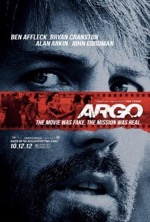
Starring: Ben Affleck
October 2012
“Inspired by actual events” movies can either be, well, inspirational or emotionally overwrought. Fortunately, Argo has a healthy dose of the former along with great performances and a steady hand at the helm in star/director Ben Affleck. Instead of being merely based on a true story, Argo is “Inspired by the incredible true story,” as the movie’s marketing materials would have us believe. When you use a superlative like incredible to describe your movie, you open yourself up to a world of ridicule if the film doesn’t live up to such a lofty assertion. Again, the movie has nothing to worry about as the word incredible is far too paltry a word to describe this Oscar contending powerhouse…that just happens to be a true story.
Superlatives aside, the film chronicles the historical account of six Americans who are displaced from the US embassy in Iran during the violent riot/siege in 1980. Forced to hide out at the Canadian ambassador’s (Victor Garber) house, our half dozen citizens must evade capture long enough for our government to figure out a rescue plan. Enter CIA agent Tony Mendez (Affleck), a specialist in such dangerous extractions. He has a plan…sort of. Gleaning inspiration from his son’s choice of TV entertainment, a Planet of the Apes movie, Tony devises a scheme where he will fly into Tehran as a location scout for a sci-fi movie and fly back with his “film crew.” What could possibly go wrong with that plan?
As Bryan Cranston’s Jack O’Donnell says, in one of the movie’s many memorable lines, “This is the best bad idea we have…by far.” However, if the cause is just, sometimes fate will conspire against probability and even a bad plan will work like magic. Such is the case here, except for the magic part. It takes forces far more powerful than that to get our citizens back home…teamwork, tenacity and a ridiculous amount of happy coincidence.
However, when it comes to movie magic, the film has it in spades: besides a terrific script by Chris Terrio (based on Mendez’ memoir), sure-handed direction by Affleck, sweeping cinematography by Rodrigo Prieto, milieu appropriate coifs, costumes, sets and archival news footage (and an old toy collection I’d die to get my hands on, shown at movie’s end), what puts it over the top is the film’s knowing jabs at Hollywood. John Goodman, in a sensational supporting role as make-up expert John Chambers, tells Mendez that he’ll fit right in pretending to be a Hollywood big shot. Another terrific supporting role is turned in by Alan Arkin, who plays an out-of-step movie producer whose every utterance in the film lands like a well-timed punch line, particularly the oft used play on words, “Argo f@!k yourself.” The film never takes itself too seriously, which is its greatest weapon and asset. So then, Argo can be called a biopic with bracing drama and selective moments of comic relief. This is as close to a complete movie as you’re ever likely to experience.
When the action heats up in the later acts, the film becomes a first-rate thriller. Indeed, the film’s climax, specifically in the way all of the moving parts have to work just perfectly in order for our heroes to be saved, is reminiscent of the pulse-pounding intensity of Apollo 13 (1995), another high stakes drama based on actual events. In addition to edge-of-your-seat climaxes, both films also have stand-up-and-cheer endings.
Any way you slice it, Argo is a superior film and should rack up a clutch of Oscar nominations/wins come awards season. Depending on how Mr. Spielberg’s Lincoln turns out, Argo just might waltz off the stage with the top prize: an Oscar for Best Picture certainly isn’t out of its reach. Prognostications aside, Argo is the finest biopic that’s come along in quite some time. Sometimes true stories based on bad ideas make for great movies.
Rating: 3 1/2
Taken 2 (PG-13)
02/02/14 23:05
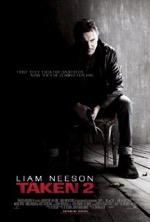
Starring: Liam Neeson
October 2012
The follow-up to the successful thriller Taken (2008), Taken 2 is leaner, meaner and doubles the number of kidnappings. This time around it’s a family affair as Liam Neeson, Famke Jansen and Maggie Grace, while vacationing in Istanbul, are targeted by Albanian thugs with a grudge against Neeson for his former transgressions against their family. Grace’s Kim was the one taken in the last film, but she evades capture this time, thanks in large part to a major assist from dad. Turning the tables, Neeson’s Bryan and Jansen’s Lenore are abducted by the avenging Albanians.
Admittedly, the formula is very much the same here as in the first film: foreign locale, high speed chases, high body count, etc. Other similarities to the earlier movie are flaccid character development and plot holes so large that even Kim can parallel park inside of them: case in point, Kim goes from twice failing her drivers test to zipping through the narrow, teeming streets in Istanbul as if she’s the second coming of Jason Bourne. Besides the utter silliness of the chase scene, doesn’t Kim look a little old for a high school student? Perhaps she was held back a few years. Oh, and how many times must Bryan admonish Kim to speed up, go faster, etc (you can create a drinking game with such repetitions) before she finally follows her dad’s instructions?
With a running time of ninety-two minutes this second Taken installment is definitely lean, which is a good thing since a longer film would’ve made it even more obvious just how little story there is here. The plot’s breakneck pace further distracts the audience from realizing they’re viewing a ridiculously simple through line, heavy on action and nearly devoid of any character complexity. On the upside, the movie doesn’t overstay its welcome. On the downside, the “climactic” showdown between Bryan and the aggrieved father from Albania is akin to air escaping a balloon…the very definition of anti-climactic. We’re waiting for a rejoinder, another bigger, cooler battle like we’re used to seeing in the standard action picture. Taken 2 is the exception to that rule—the bad guys are finished off, the frazzled family is reunited and the movie ends…but not before Kim passes her driving test to the downpour of warm fuzzies. The film feels rushed and could actually use and additional ten to fifteen minutes of story; a panacea I prescribe for very, very few films.
In the end, Taken 2 is no better or worse than its predecessor and extends the series without necessarily advancing it. Still, if popcorn entertainment is the order of the day, it’s hard to go wrong with Taken 2. Some will enjoy the film for the pulse-pounding romp that it is while others will feel like they’ve been taken for a ride.
Rating: 2 1/2
Trouble with the Curve (PG-13)
02/02/14 23:00
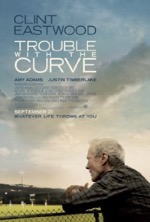
Starring: Clint Eastwood
September 2012
There were rumors that Gran Torino (2008) would be Clint Eastwood’s swan song as an actor, but fortunately the lovable curmudgeon is back in the saddle in Trouble With the Curve, a middling baseball yarn directed by Robert Lorenz. Here, Eastwood plays a crusty baseball scout who’s too proud to get an eye surgery or use a computer for stat analysis, despite his daughter’s (Amy Adams) incessant urging to get ocular support for the former and his boss’ (John Goodman) eternal consternation over the inefficiency of the latter. Adams is an up-and-coming lawyer who can spit out baseball stats like Vin Scully…a chip off the old block, though her career choice is a disappointment to Eastwood, who had trained Adams from her youth to eventually fill his shoes. Justin Timberlake, who’s a rival to Eastwood and love interest for Adams, introduces a change up element into the middle of the plate narrative. Or to put it another way, the story would’ve been pretty vanilla without Timberlake’s twist of wild cherry.
One of the major plot points involves a young slugger who has a ton of talent and confidence, but also plenty of attitude and arrogance to match. Goodman, along with front office staffers Robert Patrick and Mathew Lillard, must decide whether or not to draft the young phenom over Eastwood’s objections concerning the player’s dubious potential. But with failing eyesight and archaic scouting methods are Eastwood’s evaluative skills to be trusted with a big paycheck on the line?
Trouble sets up well with Eastwood’s physical impediments, Adams’ struggle to make partner at a law firm while helping out stubborn dad, Timberlake’s hero worship of Eastwood and schmoozing of Adams and Goodman’s constantly challenged loyalty to Eastwood by Patrick and Lillard. There are some good character moments throughout, like Eastwood’s utter inability to have a conversation with Adams about anything other than baseball. An insider’s look at the baseball scouting process and interactions between scouts and the front office is mildly diverting, and the character beats are marginally intriguing, but the film, much like the young man being scouted, fails to deliver on its potential.
The trouble with the film is its ending: contrived to the point of absurdity, the populist notion that a kid who’s never played on a baseball team can strike out a slugger at the top of the draft class is reassuring and heartwarming, but utterly ludicrous. Adams’ decision to leave behind a promising career in law to follow in daddy’s footsteps is also oversimplified and overly idealistic. It’s just another populist climax for viewers who get off on that type of roses and rainbows ending. Also, and not that a film must always tie up all of its loose ends, but we never learn if Eastwood undergoes eye surgery or if he decides to stay with the game or retire.
With the film’s pedigree I expected a lot more from it; maybe not Field of Dreams (1989) but perhaps something comparable to The Rookie (2002). Unfortunately, this film isn’t as magical as the former or as inspirational as the latter. Trouble has a few solid innings, but strikes out in the end.
Rating: 2 1/2
The Master (R)
02/02/14 22:54
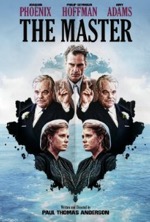
Starring: Philip Seymour Hoffman
September 2012
The Master has all of the directorial deftness, acting acumen and narrative nuance one could hope for in an instant classic. It’s as if the word Oscar is subliminally inscribed onto each individual frame of the film. As the movie languidly rolls along, all you see is Oscar...Oscar...Oscar. Whether or not the film’s formidable array of talent and production values translates into actual statuettes remains to be seen, but a more obvious example of Oscar bait you’re not likely to find.
Paul Thomas Anderson’s direction is utterly mesmerizing, aided in subtle yet profound ways by Mihai Malaimare Jr.’s sumptuous cinematography. Philip Seymour Hoffman is typically terrific as a charismatic cult leader and Joaquin Phoenix is masterfully magnetic as an aimless, restless lush—he’s taken his performance as Johnny Cash in Walk the Line (2005) and slathered on new layers of physical ticks and mental neuroses. Amy Adams is effective in her role but there isn’t as much meat on the bone here as there was in her last outing with Hoffman in the dramatically taut Doubt (2008). Laura Dern has even less screen time than Adams, but makes the most of a pivotal supporting role as a passionate acolyte of Hoffman’s dianetics-esque religion.
Performances aside, the story is a rich, multi-layered yarn that has much to say about humanity’s search for significance in the ebbs and flows of life. Phoenix is the yin to Hoffman’s yang…in a strange twist of fate the two become unlikely friends. In unexpected yet undeniable ways, one is the answer to the other: Phoenix lacks structure and focus and Hoffman needs more insouciance and spontaneity.
The Master is a microcosm of our collective struggle to ascertain the reason for being. The film’s paradoxical layers of meaning are as insidious as they are insightful: just as spectators strive to apprehend the purpose of their own existence, the characters in the film also seek to understand their role and place in the cosmos. In a shrewd attempt at indoctrination, the film projects its prescriptions and hypotheses of sentience through its characters onto the viewer, who then must embrace or outright reject such precepts based on previously formed beliefs and world views. Though the film appears benign, it is extremely aggressive in its refusal to leave us unchanged where life’s big questions are concerned.
However, for all of its ostensibly insightful glimpses into the essence of existence, the story ends up being little more than a manifesto for the free thinking, existential, touchy-feely set. Despite it’s utterly engrossing narrative, brilliantly told and visualized by Anderson, The Master will undoubtedly leave its audience in a “huh?” haze as the end credits roll. It’s not that the plot is too hard to follow or its structure too complex, but when all is said and done what does it all mean?
In the same way that Clint Eastwood’s Hereafter (2010) posed many questions about the afterlife but ultimately proved inadequate at answering any of them (of course), The Master posits numerous notions concerning the nature of reality but fails to convince the audience of its doctrines. In the end, the film’s lasting relevance will be more for its artistry than its philosophy (sophistry?). Maybe the real answer to existence is striking the balance between Hoffman’s relentless pursuit of knowledge and Phoenix’s unbridled lust for life.
Rating: 3
Arbitrage (R)
02/02/14 22:49
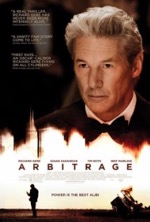
Starring: Richard Gere
September 2012
So here we have a standard movie about a workaholic male who makes bad financial decisions, has an affair, gets caught red-handed in both and ends up loosing everything (no spoiler alert here since most of this is discernible from the trailer). The basic plot of Arbitrage has been employed a thousand times before, and has been executed far better on a number of occasions. The movie threatens to degenerate into a Lifetime movie at times, but the compelling characterizations, coupled with the typically stellar performances by Richard Gere and Susan Sarandon, hoist this film to the top third of dramatic morality plays.
Gere’s turn as corporate giant Robert Miller is a disquieting portrait of modern man. Miller is driven by success, greed, lust and the failing notion that he can be provider and protector for the women in his life. Turns out Miller’s wife, daughter and paramour all need protection from him and his calamitous choices. Like many of his real life contemporaries—the Bernie Madoff’s of the world—Miller is able to keep all of the plates spinning in the air for a time, but is ultimately doomed to fiscal failure as well as public and private humiliation. The film’s resolution is intentionally left ambiguous, but none of the possible outcomes are ideal where Miller’s future is concerned.
When all is said and done, Arbitrage isn’t a barnburner, but isn’t a bad way to spend a couple hours either. The performances alone should keep viewers engaged in the slow boil narrative. The universal moral “you play with fire, you get burned” is worth reinforcing, I suppose, lest someone has forgotten such lessons imparted in the latest episode of Law and Order or NCIS. Though not quite an ode to modern males, the film posits some fascinating notions regarding this allegedly endangered gender. Great performances with some food for thought…who could ask for anything more?
Rating: 3
The Dark Knight Rises (PG-13)
02/02/14 22:43
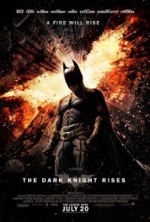
Starring: Christian Bale
July 2012
So how do you improve upon a film that was a global phenomenon (one billion worldwide gross) and also featured the unforgettable, posthumous Academy Award winning performance by Heath Ledger as the maniacal Joker? Though a daunting question to grapple with, the obvious answer is that you take the sequel in a different direction. Director Christopher Nolan certainly achieved that in his darker, grittier trilogy capper, but did he choose the right direction?
The movie opens with a spectacular midair heist that introduces us to the movie’s formidable villain, Bane (Tom Hardy). A robbery at the Wayne Manor establishes the other villain/wildcard in the movie, Anne Hathaway’s Catwoman. Bruce Wayne (Christian Bale), a battered shell of his former self, is on hiatus from his jaunting about as Batman and is set to be voted off the board of his own company due to bad business decisions. To make matters worse, Wayne’s longstanding, long-suffering butler, Alfred (Michael Caine), leaves the Wayne Manor over a dispute with Wayne. With the death of Rachel Dawes (Maggie Gylenhaal) in the previous film, Wayne now has little, if anything, to hold onto. And all of this occurs before the action with Bane kicks into high gear.
Kicking the hero while he’s down is okay as long as he eventually emerges as the hero we know and love. That Batman, however, never makes an appearance in this film. You’d think that with the word rises in the title, Batman would overcome his mental and physical infirmities and avenge himself upon Bane, but his role in the film’s resolution is anything but triumphant. One of the points frequently stressed in the movie is that Bruce Wayne/Batman can’t do it all by himself, but it would be nice if he did something…other than get his butt kicked in every melee he’s a part of in the movie. As such, though brimming with gritty realism, the film gives us little to cheer about or for. By movie’s end, the whole sordid affair amounts to little more than a bleak exercise in anarchy.
As for Batman’s fighting style in the film…it’s annoying. He’s out of control and impatient, forcing punches in a berserker style that should be Bane’s method of attack. Did Batman forget all of his training? If anything, shouldn’t Batman, as an experienced fighter, be the more restrained and patient of the two combatants and use Bane’s bulk and momentum against him?
I repent of ever criticizing Batman’s (Bale’s) hushed and throaty speech, because Bane’s muffled and mechanized vocalizations are exceedingly difficult to decipher at times. I’m not sure I’m sold on Nolan’s take on Bane. I much prefer the Bane from the Venom storyline in the Batman comic books. True, Bane is more compelling if he isn’t under the influence of an illicit substance, but the Venom-enhanced Bane is far more frightening since there’s just no reasoning with him. Although I’m certainly not advocating a return to the goofy sidekick caricature of the character in Batman & Robin (1997), a Venom-infused Bane, if handled properly, is one of the most formidable and ferocious members of Batman’s rogues gallery. Plus, by introducing Venom into the Bane storyline, how awesome would it be if Wayne also got hooked on the juice like he did in the comic, unleashing a more savage side of the Caped Crusader? The Venom storyline would seem to be tailor-made for a story about a physically battered Batman in desperate need of a physical edge against an imposing, seemingly impervious adversary.
The film has some severe highs and lows, both thematically and critically. Fittingly, the movie’s high point is when Wayne gains the courage to leave the hellish gulag by ascending the jagged walls of an ostensibly bottomless well. The sequence works on different levels: symbolically (Wayne literally rising above past fears, mistakes, etc.) and personally (as the film prefigures, Wayne must find the anger, focus and motivation to return him to his former status, if not physical condition, as Gotham’s protector).
Another aspect that works well here is Nolan and cinematographer Wally Pfister’s sweeping city shots, which are some of the finest in Nolan’s Batman trilogy. The city shots featuring pyrotechnics are utterly mesmerizing, especially the double bridge explosion. The most exciting visual in the film is at the Gotham Knights football game when, during a kickoff, a sprinting player stays one step ahead of the collapsing field which falls away in sections behind him. Though only consuming a few seconds of screen time, it’s a gorgeous yet gut-wrenching visual.
Of course, bridges exploding and sections of the city crumbling beneath the surface are rife with 9-11 imagery. Just as he did in the previous Batman films, Nolan taps into lingering anxieties over 9-11 by showing a city being ripped apart at the seams by a terrorist. As such, the film’s most obvious 9-11 allusion is Bane himself—a self-styled, self-righteous terrorist with misguided populist notions of an ideal society operating under his jackboot. Bane sees himself as a type of Robin Hood, an avenger for the people (who’s ultimately in it for himself). Bane’s men stealing Wayne’s Bat-Tanks and unleashing them on the city to wreak havoc echoes the way terrorists used our own technology against us on that fateful day in 2001. Besides blowing things up, Bane’s mission also includes bringing corrupt political leaders, tycoons, etc to justice for their decadent lifestyles. By using his antagonist as a type of avatar, Nolan exposes corporate greed and political pork by borrowing from real life headlines ranging from the Enron scandal to the financial fleecing by the city council in Bell, CA.
Getting back to the Bat-Tanks, wouldn’t engineer Lucius Fox (Morgan Freeman) have built in an optical scanner failsafe so that only Batman could use them (with thanks to my sister for pointing this out)? Other than the Bat-Tanks, the newest toy in this movie, not to be outdone by the more heavily armored Batmobile in the previous film, is the envy inducing Bat-Bike. The way the Bat-Bike takes corners, it’s round front tire somewhat reminiscent of the swiveling ball on a Dyson vacuum, is another of the film’s visual delights…it really must be seen to be fully appreciated.
I have neither the energy nor the inclination to detail an exhaustive list of the movie’s inconsistencies or gaps in logic, but one sequence in particular is addled with numerous errors. After being convicted in Bane’s kangaroo court, Commissioner Gordon is sent out onto a river covered in thin ice. Three problems here: when Batman shows up, he’s standing right where others have already fallen through the ice. With the added weight of his suit and all of its various equipment, gadgets and weapons, wouldn’t Batman be in serious danger of falling through the cracking ice? Next, Batman lights a flare and throws it down onto that same cracking ice. Is this a good idea?
Worst of all, the flare ignites a trail of gunpowder which begins on the ice and ends up lighting up a makeshift Bat Symbol high atop a distant skyscraper. Did Batman arrange this gimmick all by himself? How long did it take him to lay that trail of gunpowder and wax artistic on the side of the building? Wouldn’t that time have been put to better use by rescuing Gordon and foiling Bane’s plans?
This flawed scene is a microcosm of the film’s lazy lapses of logic, but it’s not just story elements that miss the bull’s-eye. Everything, from the dialog to the pacing to the action scenes, just feels “off” here. Whereas the previous film was a flawless sensation, this third Batman installment is riddled with incongruent story devices and plot holes large enough to drive a Bat-Tank through with room to spare. Much like Wayne and the city he protects, the story here seems battered, fractured and beleaguered. In that regard, the narrative’s reflection of Wayne’s psyche is brilliant, but does it necessarily make for an enjoyable entertainment?
It’s hard to say if Nolan’s intention was to trigger a cathartic release in the audience over Bane’s avenging mission against corporate and political corruption, but it’s safe to say that there’s no way he could’ve predicted the film’s potential to produce anarchy in real life. I speak, of course, of the incident at the theater in Aurora, Colorado, where a young man, decked out in Bane garb, killed and wounded several patrons in a wanton slaughter. The shooting has tainted the film in profound and palpable ways—it’s not just an entertainment anymore, it’s a heinous headline. Ironically, the film’s message that evil is real and rampant is starkly validated by this opening night massacre. When entertainment inspires actions in real life and tragedy ensues, it’s hard to know where the blame should be placed. One thing’s for sure, no matter how well the film performs; the theater shooting will always stand out as an unfortunate footnote to whatever the movie achieves financially, critically or artistically. However unintentional, the movie has created its own monster…life imitating art has seldom been as bitterly realized.
It’s hard to imagine a darker, more psychologically complex film than The Dark Knight, but Nolan has delved deeper into the sordid, corrupt and festering underbelly of Gotham while presenting us with a villain even more frightening (though not nearly as colorful) than the Joker. However, for all of its gritty realism, The Dark Knight Rises gives its audience absolutely nothing to cheer about. The movie is bleak for the sake of being bleak, and as such, is an extremely well-crafted, well-acted, well-written and well-directed movie that’s ultimately not enjoyable in the least. It’s entertaining but is nowhere close to being exhilarating. It’s hard to say where Nolan should’ve taken this film or even if a different plot would’ve produced a different result, but the direction he took is less than satisfactory, especially when one considers how well it was set up by The Dark Knight.
Perhaps that downer feeling comes from the knowledge that there’s no easy way to say goodbye to Bale, Caine, Freeman, Oldman and company. Perhaps the previous film set the bar impossibly high, bloating our expectations for a more triumphant capper to Nolan’s brilliantly dark trilogy. Perhaps the film with be looked upon more favorably as time passes? Perhaps the Dark Knight will rise again?
Rating: 3
The Amazing Spider-Man (PG-13)
02/02/14 22:37
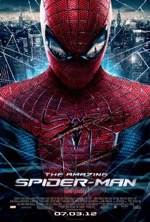
Starring: Andrew Garfield
July 2012
Both films in Marvel’s Fantastic Four franchise were mediocre affairs that failed to live up to their exceptional title. Here we have a movie with the word amazing in its title. The danger with using a superlative in a title is that if the project fails to live up to such boasting, the drubbing received from critics, audiences and the media could be unbearable. So then, does the new Spider-Man film live up to its lofty name?
Before addressing that inquiry, it’s important to answer the even bigger question looming over this film—why reboot the franchise since the last Spider-Man movie was released in 2007? Isn’t it too soon for a new Spidey flick? With Sam Raimi’s trilogy fresh in our minds, it’s impossible to avoid a compare/contrast evaluation of the former Spider-Man (played by Tobey Maguire) and the new one (played by Andrew Garfield). While both casts, from top to bottom, are equally impressive, the edge in the director category clearly goes to Raimi, who beats Marc Webb (surely a cosmic practical joke linked director and project) handily. Raimi’s Spidey films are much more cinematic than Webb’s effort, which, save for the three or four action scenes, plays like a well-acted drama on Lifetime rather than a high-octane summer blockbuster. The action scene settings themselves are vastly different—Raimi’s take place on skyscrapers or on a high-speed train, while Webb’s take place on top of a corporate building, in a high school science lab or in the city sewer (though still contrived and predictable, this was an exciting setting for a melee).
As for the men inside the Spidey suit, Maguire infused his Peter Parker with a nerdy, angsty vibe, while Garfield is a bit more subdued and contemplative. Where Maguire’s Parker is giddy upon discovering that he has superpowers, Garfield’s Parker seems to take it all in stride, as if the enduing of superpowers was an everyday occurrence. To be fair, Garfield does show some emotion and excitement during the skateboard scene, but his response is noticeably more reserved than Maguire’s when he first learns how to climb walls and shoot webs.
In the original trilogy, Gwen Stacy (Bryce Dallas Howard) was written as a kind of floozy tasked with driving a wedge between Parker and his heartthrob, Mary Jane Watson (Kirsten Dunst). Here, Gwen (Emma Stone) is the whip smart intern for Dr. Curt Connors (Rhys Ifans) a.k.a. The Lizard. Stone is absolutely delightful in the film and brings an effective mixture of intelligence and compassion to the role. The one nitpick here is that she seems a bit too experienced and knowledgeable to still be in high school—the Juno Syndrome.
As for Ifans (Pirate Radio), his character is neither as psychotic as Willem DaFoe’s Goblin nor as maniacal as Alfred Molina’s Dr. Octopus (we’ll leave the pathetic villains in Raimi’s third film out of it). Like Doc Ock, Connors has a redemptive act near the film’s conclusion, but his effectiveness as a villain is diminished by minimal screen time and shallow character development.
Where Peter’s aunt and uncle are concerned, you can toss a coin as to whether the original Cliff Robertson/Rosemary Harris pairing is better than the new Martin Sheen/Sally Field duo. One of the most interesting new characters is Denis Leary’s Captain Stacy. The “meet the parents” dinner where Peter insults the police force, and Stacy by extension, is quite amusing.
As for the movie’s visual effects, they’re serviceable if not remarkable—surely special effects were one of the main considerations in updating the franchise. Are these FX that much better than those employed in Raimi’s trilogy? I would argue that the cinematography, and perhaps the visual effects themselves, are more inventive and cinematic in the trilogy than in this film. Not quite the bold leap forward I was expecting.
The first Spider-Man film was released on the heels of 9-11 and gave us a champion to cheer for—timing is everything and Spidey was the hero of the hour, the symbol of freedom we desperately needed to allay our fears and galvanize our resolve against the evil that exists, and frequently manifests itself, in our modern world. Spider-Man captured the zeitgeist like few films before or since. So then, what societal issues or ripped-from-the-headlines events does this new Spidey film broach? Well, other than ethics in genetics and the inability of law enforcers to keep us safe…nothing. This take on the wall crawler, like its predecessor, features teen angst aplenty, but we’ve seen it all before.
In the end, The Amazing Spider-Man is an earnest film, but not necessarily an exciting film…one might even say it’s borderline boring at times. This is somewhat ironic when considering that Webb’s previous effort, (500) Days of Summer, was an indie sensation featuring fine performances, innovative direction and a narrative change-up to the typical dating movie formula.
Too soon to reboot? Time will tell, but if I’m honest with myself, I probably would’ve thought this film was pretty good if I’d never seen Raimi’s trilogy. That might not be fair to this effort, but you know what they say about life.
Rating: 2 1/2
Brave (PG)
29/01/14 23:48
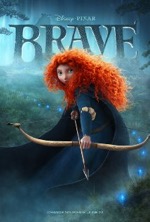
Starring: Kelly Macdonald
June 2012
Pixar’s thirteenth film, Brave, is a bold departure from the studio’s last couple of releases, both of which were sequels and featured the exploits of toys and cars, respectively. Brave has pioneered a few firsts for the stalwart studio: somewhat surprisingly, this is the first period piece produced by the studio. The movie is set several centuries ago in the Scottish Highlands. Brave is also Pixar’s first fairy tale, told in a conspicuously classic Disney manner. Brenda Chapman is the first female director of a Pixar film. Most importantly for those who’ve been critical of the studio’s purportedly misogynistic or chauvinistic tendencies, the film features the first female title character in any Pixar film.
Some will argue that Brave is Pixar’s answer to DreamWorks’ How To Train Your Dragon (2010), but the two animated films are vastly different. For starters, there aren’t any colossal, reptilian fire-breathers in Brave. Secondly, in Dragon young lad Berk seeks approval from his father while Brave’s Merida pulls out her long, thick, red hair in defiance of her overbearing mother’s insistence on her adherence to decorum and tradition. Ultimately, Brave has more in common with early Disney animated movies than it does with DreamWorks’ foray into Medieval times, particularly any Disney classic that features an old, wart-nosed, spell-casting witch.
Less obvious is Brave’s commonality with Disney’s Brother Bear (2003), specifically in the way the spell transforms effected characters. Another element borrowed from the Disney back catalog is the archery contest first seen in Robin Hood (1973). In that movie, archers competed for a kiss from the fair Maid Marian, but in Brave, contestants are vying for Merida’s hand in marriage (until Merida pulls out her bow and shows them all how it’s done). Of course, a young lass with a bow and arrow isn’t exactly original either…Susan was a fair shot in the Narnia films and, more recently, Katniss was deadly accurate in The Hunger Games (2012). Although Merida and her mother don’t switch bodies, the way the women eventually come around to the other’s point of view definitely has shades of Freaky Friday (1976, 2003). You could also say that firelocks and the three little bears steal the show at the end, yet another allusion to a literary antecedent.
All of this to say that Brave certainly isn’t the most original of the Pixar films. However, the studio’s ability to weave these familiar story threads into an intricate tapestry of high-spirited, hilarious and heartfelt moments is really quite astounding…you might even say uncanny. And there can be no doubt that like the many early Disney animated features it emulates, Brave is brimming with that elusive quotient called movie magic.
Other than the witch’s spell, the most magical element in the movie is the tiny blue sprites called wisps. Besides looking and sounding cool, wisps are like mini spirit guides that lay out a course for the characters to follow, much like breadcrumbs in the Hansel and Gretel fairy tale. The tribute to Steve Jobs, as his wisp ascends heavenward, during the end credits is a class move by the studio who owes the departed visionary a huge debt, both creatively and financially.
Though Brave probably won’t go down as essential Pixar viewing, it succeeds on its own right and has blazed new trails for the studio. Whether or not Brave is your cauldron of brew, you’re sure to find it a significant improvement over last year’s stuck-in-neutral Cars 2. The studio is back on track.
Rating: 3
Prometheus (R)
29/01/14 23:41
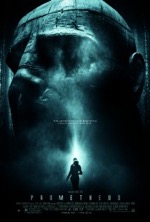
Starring: Noomi Rapace
June 2012
The opening sequence of Ridley Scott’s highly anticipated Alien prequel, Prometheus, is, perhaps, the most startlingly original teaser in the history of sci-fi films. An albino humanoid stands near a mountain stream, drinks some strange viscous concoction and begins retching. The sequence simultaneously begs a host of questions. Who is this strange-looking alien? Where does he come from? Is he on Earth of the distant past or future or some planet that looks just like the Scottish Highlands? And just what exactly is that disgusting grog the guy drinks (bad Romulan Ale)?
These questions are just the tip of the proverbial iceberg in an intentionally murky movie that will probably leave many audience members feeling lost. It seems fitting, then, that one of the film’s script writers is Damon Lindelof, co-creator of TVs critically acclaimed Lost, which was also a mythology heavy, mind-bending slice of top shelf sci-fi. Ironically, Prometheus’ opening sequence is a microcosm of the entire film: beautifully crafted and filmed, yet frustratingly cryptic.
By now, the Alien universe has been so well established (themes, iconography, etc.) that innovation is hard to come by. Many of the film’s new elements work just fine, but old patterns are hard to break and creep in as if on cue. Case in point, no Alien movie would be complete without a decapitated android and here that bill is filled by Michael Fassbender’s eerily serene David, who pops his top late in the film. A narrative mainstay in many Alien films is the lead female being impregnated by an alien; in this instance the hapless heroine is Noomi Rapace’s Elizabeth Shaw. Here, Shaw uses laser scalpels and other hi-tech medical instruments to abort the alien fetus from her own distended belly…easily the most creep-tastic sequence in the film, doubly so for men I’ll wager.
Another cliché: dumb characters don’t stand a chance when the bloodletting begins. Not only are these engineers more doltish than the typical scientists, they can’t regulate the impulse to touch items that can potentially destroy them once inside the alien structure—even when the impending danger is clearly pointed out to them they’re still powerless to resist handling foreign objects. I guess scientists and engineers will always be kids in a candy store whenever alien artifacts and technology are present.
When it becomes obvious after the initial round of introductions which person will be the first victim you know your story is a tad too predictable, and Prometheus certainly doesn’t break that mold. Sad thing is, we really don’t care when these ancillary characters die because, as with Star Trek’s “redshirts,” we don’t know the first thing about them…they’re disposable to us and the story. If there hasn’t been any investment in character development, why should we care if they die? We don’t, and that’s the point.
If there’s one area of the narrative that invites scathing criticism it’s the frequent trips to the alien fortress. After loosing all of their engineers on their first foray, what would induce the remaining characters to go back for a repeat visit? Curiosity? Stupidity? Pressure from the filmmaker who only has half a film at this point and needs a higher body count to earn an R rating? But they do go back, again and again...like lambs to the slaughter. And people keep dying. At some point you’d think the characters would figure out that the alien haystack isn’t the Matterhorn ride at Disneyland.
Worse than the frequent trips to the alien slaughterhouse is that we’re taken along for the ride each time and always from a low angle perspective of the tire rim or a helicopter shot of the motorcade approaching the alien structure. These exterior shots leave us feeling cold, effectively on the outside looking in. Why didn’t Scott utilize these segues to give us some good-natured banter among characters or little glimpses into the back stories of these individuals, a la the Humvee scene early in Iron Man (2008)? As is, these ping-pong ventures between the ship and alien fortress are squandered opportunities to shore up one of the film’s most sorely lacking commodities—character development.
Although the climactic ship collision/crash is visually spectacular, the resulting nonsense of characters trying to get out of its path could’ve been trimmed from the film with little consequence. It’s one thing if you’re Indiana Jones trying to outrun a steamrolling ball of death down a narrow tunnel, but it’s something entirely different if a ship is falling in your direction and you’re in the middle of an expansive plain. This type of imperilment is common in movies and I always end up asking myself, do characters not realize they can run to one side or the other to avoid what’s rolling/moving straight toward them? Why must they run in a straight line in an effort to outrun the object of impending danger? It must be plain idiocy and an utter lack of knowledge regarding the laws of physics and gravity that drives these characters’ actions. Even more egregious is the amount of screen time dedicated to this ostensibly thrilling sequence which fails to advance the plot in any significant way. The entire sequence is nothing more than a self-indulgent excuse to employ a massive set piece in order to generate a shallow thrill for the audience, something Michael Bay would normally do, not Ridley Scott.
In the final analysis, Prometheus will only be admired by those who enjoy a hard sci-fi yarn that grapples with the questions of existence, but ultimately fails to answer those questions in the end. Action junkies will be disappointed in the film as will those who’ve come to expect a certain amount of intensity and gore from the franchise. Though Scott’s original Alien (1979) did far more with a lot less, Prometheus is still a handsomely mounted, visually staggering film. As an art film under the guise of a commercial release Prometheus may, well…alienate a large portion of its audience.
Rating: 2 1/2
The Best Exotic Marigold Hotel (PG-13)
29/01/14 23:36

Starring: Judi Dench
May 2012
It’s been a knock on many modern movies that most of the best scenes/lines are spoiled in the trailer. So then, it was with natural skepticism and trepidation that I braced for the worst with The Best Exotic Marigold Hotel (based on the novel by Deborah Moggach), since so many memorable moments were featured in the trailer. Surely there wouldn’t be anything left to the story, right?
Despite predictable rom-com subplots and a straightforward narrative, the movie maintains interest throughout thanks to the breathtaking location work and spellbinding performances from the luminescent cast, headlined by Judi Dench, Tom Wilkinson, Bill Nighy and Maggie Smith. When his character is asked what he sees in India, Wilkinson replies, “The lights…the colors…the smiles.” Indeed, the locations, extras and overall ambience serve as a main character in the film. In reality, if this story had been set in NYC or even Paris it would have retained the much of the same dramatic punch, but it probably wouldn’t have had the same, well…exotic appeal. As they say in real estate, “location, location, location.”
The various character vignettes are all well written and acted, and director John Madden (not the football guy) wisely keeps fancy camera movements to a minimum so as not to upstage the gorgeous Indian vistas. These serialized subplots, which occasionally intersect with the main plot, effortlessly bounce from one set of characters to another and somehow manage to move the story along without coming off as a big screen soap opera. Though not overly complex and predictable throughout, Exotic is a life-affirming tale rich in character and beauty. The film’s underlying assertion that it’s never too late to embark on a new adventure should resonate with viewers of all ages. Just remember, “Everything will be alright in the end.”
Rating: 3
The Avengers (PG-13)
29/01/14 23:28
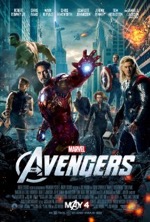
Starring: Robert Downey Jr.
May 2012
One of the most highly anticipated superhero movies to come along in quite some time, The Avengers is the culmination of years of setup: Marvel executives felt that the best way to ensure the success of an Avengers film was to produce individual movies for all of the main characters so that the audience would be familiar with their origin stories and wouldn’t be jumping into this new adventure cold...an enormous financial gamble with tremendous earning potential if the gamble paid off. Although timing was a major consideration for this film, the main concern was that of plotting—would an Avengers movie collapse under the weight (considerable in the Hulk’s case) of so many superheroes and their corresponding A-list stars? Most will applaud fan favorite writer/director Joss Whedon for pulling off the balancing act of the decade, and on the face of it they’d be right for feeling that kind of fierce pride over his achievement here. However, I feel Whedon’s juggling act works on one level while failing decisively on another…and it’s a big one. To use an analogy, however skillful the actual juggling is, using flaming torches is much more impressive than using, say, tissues. Although appearances would suggest that Whedon has given us the former, he’s actually cleverly foisted the latter upon his audience. Let me explain…
The “character moments” that serve as the ad hoc glue to hold all of the action sequences together (and from becoming one run-on melee) are extremely flimsy and don’t really tell us anything new about the characters: Bruce Banner/The Hulk (Mark Ruffalo) is angry all the time (not exactly a news flash), Thor (Chris Hemsworth) is still having troubles with his nefarious brother, Loki (old hat) and Hawkeye (Jeremy Renner) can shoot arrows with a degree of precision that would make LOTR’s Legolas jealous, but even after watching the film I have no idea what his character’s real name is. Captain America (Chris Evans) is adjusting to life in the 21st century, which is good for a few chortles, but his major character revelation is that back in the 40s his persona inspired a line of trading cards. A line early in the film suggests that Black Widow (Scarlett Johansson) isn’t just another pretty face, but that notion is belied by her lack of involvement in the plot, scant dialog and only her Sydney Bristow kickboxing skills to recommend her.
As for Tony Stark/Iron Man (Robert Downey Jr.), he verbally spars with Captain America, slugs it out with Thor, tries to rile Dr. Banner (without his suit on, which doesn’t seem very prudent) and schmoozes with Pepper Potts (Gwyneth Paltrow). Tony and Pepper officially got together at the end of Iron Man II (2010), but in this film, there’s the feeling that they’ve been dating for some time. In a film overstuffed with so many story lines, wouldn’t this subplot work better in the next Iron Man film, where it could be fleshed out in more detail? It’s ironic that some of the best “character” scenes in the movie are ones I feel would’ve had more impact elsewhere.
Stellan Skarsgard’s Prof. Selvig is relegated to a few lines of dialog, which is a big disappointment since a lot more could’ve been pulled out of the sensational actor. Even Samuel L. Jackson’s Nick Fury is sidelined during most of the movie’s action—it seems as if his function is to fret over the Earth’s plight while gently goading the hodgepodge of superheroes into forming a team that’s implied in the title and that the audience knows will coalesce at some point during the movie. In fact, this plot point exposes another narrative misfire: the group isn’t “officially” in place until nearly three quarters of the way through the film, which is a bit exhausting and belaboring for a story element that’s such a foregone conclusion.
One plot thread that does have some real-world relevance is Banner’s struggle to keep “the other guy” from emerging and making a mess of things. Banner’s admission that he’s angry all the time is tantamount to an individual in a recovery group admitting to being powerless over the compulsion to do the wrong thing. Instead of actively resisting his rage-a-holic tendencies, as Edward Norton’s Banner does at the end of The Incredible Hulk (2008), Ruffalo’s Banner fully embraces the reality of his weakness…and gains strength from such knowledge. There’s a powerful irony here. Even though these moments are fleeting (and constantly upstaged by the next wham bang action scene) there is some complexity here, which probably stands out as the zenith of character development in the film.
While on the subject of Banner/Hulk, some of the best scenes in the film come from the not-so-jolly green giant, like when he smashes skyscrapers or pounds Loki into the floor. It seems like Whedon has discovered the right look, tone and temperament for the character and it well may be that the Hulk is a situational hero rather than one that can headline an entire movie (judging from Hulk’s forgettable films released during the previous decade). But for all of the memorable moments provided by the character, some of the film’s most glaring plot holes center on the Hulk’s destructive tendencies. When Banner finally transforms into the Hulk—disappointingly halfway through the film—he recklessly chases Black Widow through the cramped corridors on the hover carrier. The Hulk indiscriminately busts everything in his path and most of it (pipes, cables, etc) looks vital to the smooth operations of the vessel.
The Hulk’s rampage through the ship would seem to undermine Iron Man’s efforts to repair the plummeting craft. Miraculously, as soon as the team has been “officially” christened, the Hulk gets along with Widow and everyone else on the team, as observed in the faux photo op of the group standing defiantly and triumphantly over vanquished Loki. Perhaps these inconsistencies explain why none of the recent Hulk solo movies have been smash hits (sorry, couldn’t resist).
Although the sheer number of action sequences (there’s enough for three movies) undermine whatever plot can be deciphered here, the match-ups themselves are a bit obvious and formulaic. This crowded bought schedule results in too many showcase fights, i.e.: Thor fights Iron Man, Thor fights Loki, Hulk fights everyone, etc. Some of these confrontations feel terribly contrived. It’s as if Whedon and company said “let’s throw Thor against Iron Man and see what happens.” Granted, these episodic brawls are endemic to comic books, but they don’t seem to have translated too well to the big screen where the action scenes seem bloated, overstuffed and unnecessary in many instances.
Again, should some of these conflicts have been saved for the next film (and is there any doubt that there will be a sequel?). The climactic conflagration in downtown NYC is immaculately storyboarded and features some mind-blowing showdowns, many of them decentralized, which sets up some wonderfully rhythmic crosscutting. If there’s a downside here, the setting seems a bit passé for a final conflict (the location looks like it was borrowed from the old Avengers arcade game). Why not pick a less hackneyed setting for the movie’s battle royal? And in deference to 9-11, why not pick on a different city for a change?
Much of the excitement (hype) over the film is tied up in the luminous stars that populate the film, but an even bigger draw, it can be argued, is the assemblage of this super group. However, we’ve seen the team approach to “comic book” films before in the X-Men and Fantastic Four franchises. This begs the question of why this film has generated such enthusiasm from fans when the whole team thing has been done, with varying degrees of success, fairly recently? Are the characters here more powerful and more interesting than those in the other movie series’? Are the actors here better or more popular than those in the other films (well, maybe this film has an edge over the Fantastic Four films). The novelty of the team approach to superhero films has worn out by now, so the anticipation over this film must be linked to some other ineffable quotient of movie magic.
In the end, The Avengers is a surfeit of FX and a dearth of actual story. Whedon’s “kitchen sink” approach to this movie means that the inevitable sequel will have even more action sequences and less plot which will put it right on par with Transformers: Dark of the Moon (2011). The Avengers leaves its audience feeling full as they exit the theater but it’s all been eye candy, which is nothing more than empty calories for the mind. Which means most people will love it…at least until the hype wears off.
Like the movie itself, this review has become overstuffed and overlong. We’ll there’s my Hulk-like demolition of the movie. And like the Hulk admiring his handiwork at the end of a battle, I’ve done all the damage I can do.
Rating: 2 1/2
The Pirates! Band of Misfits (PG)
29/01/14 23:19
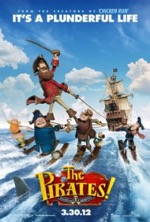
Starring: Hugh Grant
April 2012
If there’s an under-appreciated segment of the animated film industry it’s claymation, and when we use that word we’re talking about the undisputed masters of the form, Aardman Animations. Previous efforts have met with varied success: Chicken Run (2000) was fairly well received while Wallace & Gromit: The Curse of the Were-Rabbit (2005) was a runaway hit (judging from the movie’s overwhelming positive reception by audiences, critics and some golden guy named Oscar).
This time around, we’re taken along for a high-spirited adventure on the high seas, where the good guys are nineteenth century pirates and the bad guy is…Queen Victoria? Loosely based on the book by Gideon Defoe, Band of Misfits features the ne’er-do-well exploits of the Pirate Captain (yep, that’s his name) and his scurvy afflicted lot of loyal lads. Despite numerous entries, the Pirate Captain has never won the coveted Pirate of the Year award (much like Kevin Kline’s constantly overlooked Inspector Dreyfus in 2006s The Pink Panther). The Pirate Captain’s reckless pursuit of the prize becomes both premise and plot for the movie and, of course, we can’t make achieving his goal an easy one can we?
Having a fearsome disposition certainly helps, but ultimately the award will go to the pirate with the most booty…gold coins, not the snack. And so the Pirate Captain sets out to board every hapless vessel he encounters on the open sea, but comes up empty-handed when those vessels contain valueless cargos and equally worthless crews (comprised of plague victims, kids on a field trip, naturists and ghosts). But the plot thickens when the pirates board a vessel with an odd scientist named Charles Darwin, who takes an interest in the Pirate Captain’s plump parrot pet.
So how does Band of Misfits rank among the Aardman back catalog? The film is probably on even footing with Chicken Run, but certainly isn’t as refined or rousing as Wallace & Gromit. In Band of Misfits, the jokes don’t land with the precision of the latter and the action never quite reaches the frenetic pace of the former. Then there’s the story’s milieu; what it gains in familiarity it looses in originality.
Though these critiques may seem backhanded, the film is still a lot of fun and effectively combines clever and offbeat dialog (like when the captain avers that the best part of being a pirate is Ham Night) with outrageously creative visuals (like when dreaded Peg Leg Hastings arrives at the pirate gathering inside a whale’s mouth…the giant fish’s tongue rolls out like a red carpet).
The sheer logistics of producing one of these films is mind-boggling and it doesn’t seem quite fair that an achievement in claymation should be lumped together with traditionally drawn or computer generated animated films. Be that as it may, Band of Misfits probably won’t stand a chance against Pixar’s Brave of the raft of animated features coming out later in the year. Though Band of Misfits isn’t a top tier animated film, it’s certainly a voyage worth taking. Aye, matey!
Rating: 2 1/2
The Three Stooges (PG)
29/01/14 23:13
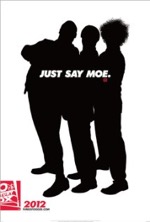
Starring: Sean Hayes
April 2012
The original Three Stooges episodes ran seventeen minutes each and many of them overstayed their welcome thanks to their exceedingly silly dialog and unrelentingly slapstick story lines. So then, how can the same brand of absurdist physical comedy, sight gags and throwaway puns maintain audience interest during the course of a full-length feature? Well, it can’t. However, The Three Stooges movie isn’t totally devoid of heart or the occasional joke that actually hits its mark (by accident in many instances).
The movie opens in a Catholic orphanage when the Stooges are young boys and immediately establishes the titular trio’s predilection for clumsiness, which is to say, innate skill at demolishing everything they see and touch. Despite putting their best foot forward, the three lads just can’t seem to entice any adopting couples to take them home—the dejected demeanors of the young actors are genuinely moving in these scenes and are a much needed change from the predictable pratfalls that dominate most of their screen time. Besides setting the tone for the movie, the orphan subplot serves as an origin story and a heartwarming denouement and is really the only element that prevents this film from being reduced to an outright bomb.
“Real” characters like Stephen Collins’ Mr. Harter, Sofia Vergara’s Lydia and Jane Lynch’s Mother Superior help to ground the film, if possible, but after five minutes spent with the adult Moe, Larry and Curly, it’s clear that these characters won’t be anything more than caricatures for the duration (though you certainly can’t fault the fully committed performances by Chris Diamantopoulos, Sean Hayes and Will Sasso, respectively). The Stooges’ dunderheaded attempt at raising money for the struggling orphanage comprises the bulk of the film and is simply a litany of lunacy. Let’s just say that if the original Stooges annoy the stuffing out of you, helping the theater staff clean toilets might be a better fate than subjecting yourself to an hour and a half of this brand of inanity.
When all is said and done, this Farrelly Brothers film is exactly what you’d expect it to be…daft and just plumb dumb. Having said that, the film does make me envious of all the youngsters I heard laughing riotously in the theater I attended. Ah, to be able to return to a time when this sort of zany nonsense actually entertained me. What do I know? Judging by the positive reaction from the movie’s target audience, this is an Oscar-worthy film.
Rating: 1 1/2
The Hunger Games (PG-13)
29/01/14 23:06
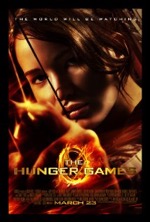
Starring: Jennifer Lawrence
March 2012
Based on Suzanne Collins’ wildly popular teen novel trilogy and directed by Gary Ross, (Seabiscuit), The Hunger Games is one of the most highly anticipated films of the year, superheroes notwithstanding. Starring Jennifer Lawrence (Winter’s Bone) and bolstered by a dazzling array of supporting talent nearly as scintillating as the dress Katniss (Lawrence) wears during the opening ceremonies of the Games, the film posits a disconcerting dystopian “what if.” What if two teenage tributes from each of twelve districts competed, to the death, in order to secure glory for the victor and more importantly, a lifetime of comfort and security for the winner’s family? Oh, and most alarmingly, the events of the game are broadcast live on Panem’s version of television for the viewing pleasure of the masses. Profits are earned from ratings and/or wagers placed on contestants. Consider it a reality show taken to the most unethical and macabre extents imaginable. But not to worry, if the global economic recession continues intensifying the way it has over the last few years, our own version of the Hunger Games will be airing on network TV this upcoming fall. Check your local listings.
The narrative love child of Lord of the Flies and The Most Dangerous Game, The Hunger Games is a highly entertaining, yet deeply disturbing, cautionary tale. The film’s most insidious and controversial attribute is its uncanny ability to coax its audience into reveling in the systematic slaughter of teens. An underlying thesis in many of Alfred Hitchcock’s movies is that all film spectatorship is inherently voyeuristic (Hitch takes this notion to its furthest extreme in his 1954 masterwork, Rear Window). If such a theory is true, then the wholesale massacre that ensues during this film’s action passages makes the audience complicit in its atrocities. To decry the teen violence in the film is one thing (which begs the question of why such protesting individuals are watching this film in the first place), but what if these scenes of imperilment and mutilation are actually enjoyable to a certain segment of the audience? Does that automatically make them psychopaths? Is it wrong to cheer when the “good” teens triumph over the “bad” teens? I mean, it’s one thing to watch adults poking holes in other adults (or aliens, robots, etc) with bullets, knives or laser beams, but it’s something entirely different to showcase teenagers slaying one another. Such is the moral minefield inherent in this seemingly straightforward survival story. But at the end of the day (or film) it’s all just entertainment, right?
The first twenty minutes of The Hunger Games contains more complexity than the entire Twilight saga. Even though both trilogies were written for a teenage readership, Collins’ The Hunger Games deals with weighty ethical and societal issues, while Stephenie Meyer’s Twilight books focus on teen angst, a love triangle and an ancient struggle between vampires and werewolves. Both movies open with a deer being stalked in the forest but the two story lines quickly and radically diverge from that point.
The dystopian mood and aesthetic is evident throughout the film, but is nowhere more apparent than in the city sequences…let’s face it, a forest is a forest, whether it’s the one just beyond District 12 or the CG forest created for the Games inside a dome, a la Star Trek’s holodeck. The soldiers employed for crowd control in District 12 during the reaping, adorned in white uniforms with white bike helmets, recall any number of futuristic enforcers, like the ones seen in THX 1138 (1971) and Soylent Green (1973). And is it my imagination or do these peacekeepers bear more than just a passing resemblance to the white clad imperial lackeys featured in Spaceballs (1987)?
The role of the command center that controls the conditions of the Games has been expanded in the movie and looks like a mix between an Apple store and the interactive virtual displays used by Tom Cruise in Minority Report (2002). Other than a modernized train, outlandish clothing, hair and makeup styles, some modern architecture and a nighttime cityscape, there’s little evidence to indicate that these people live in a futuristic, or post-apocalyptic, society. Credit the producers for minimizing costly exterior city shots and making extensive use of interiors and forest exteriors.
Director Ross hews closely to the source material; in fact, it could be argued that save for a few stylistic and narrative tweaks the movie has an almost slavish adherence to the book. In the majority of instances where this occurs a film will suffer greatly in the adaptation from book to screen but here, because Collins’ story is so rich and textured, the film actually benefits by sticking to what works. “If it ain’t broke, don’t fix it,” seems to be the overriding philosophy of the filmmaker. It’s hard to argue with the result.
In the book, much of the narrative is driven by Katniss’ internal musings and there are long passages where her thoughts and actions, without a single word of spoken dialog, move the story along toward its fateful climax. One of my major concerns with the adaptation from book to screenplay was that those personal thoughts and feelings would be lost unless a cheesy internal monolog was employed. Would we be able to discern, merely from actions or facial expressions, what was going on in Katniss’ mind? As it turns out, my fears were unfounded.
Much of the credit here goes to Ross, his cameraman and sound editor who brilliantly foreground Katniss’ thoughts and feelings with well considered, highly stylized shots. Case in point: after Katniss blows up a stockpile of food, the concussion from the blast knocks her into a state of disorientation. In the book, Katniss worries to herself that she may have gone deaf in one ear. In the movie, this fear is realized with muffled audio, a lens sliding in and out of focus and an extremely shaky Steadicam. These stylized shots are used with the utmost discretion so as not to overplay the effect. In less skillful hands, many of Katniss’ characterizations would’ve been lost in translation, but fortunately Ross and Co. deftly display Katniss’ thoughts onscreen.
All things considered, this is one of those rare instances where the movie is comparable in quality to the book upon which it’s based. The stage is set for a frenzied, fantastical franchise. Whether or not the sequels live up to this inaugural installment of Collins’ trilogy remains to be seen, but either way, this film has left me hungry for more.
Rating: 3
Jeff Who Lives at Home (R)
29/01/14 20:05
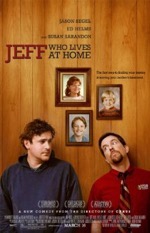
Starring: Jason Segel
March 2012
Jeff Who Lives at Home is a quirky, slice-of-life dramedy that’s carried on the capable shoulders of its stellar cast: Jason Segel, Ed Helms and Susan Sarandon portray the film’s central, dysfunctional family.
Sharon (Sarandon) is a cubicle-bound, middle-aged woman seeking some adventure amid the doldrums of her daily routine. Pat (Helms) is a hardworking stiff who misguidedly thinks that buying a new Porsche will somehow resurrect his floundering marriage. Jeff (Segel) is a superstitious homebody stricken with a lack of ambition and has a bought of agoraphobia. Yes, this is the Jeff referenced in the title, and though his brother and mother figure prominently into the plot, the central through line is Jeff’s meandering journey of self-discovery, which features a character arch that begins with Jeff near-catatonic on a couch and ends with Jeff as a bona fide hero.
The film has a heavy quotation of M. Night Shyamalan’s Signs (2002), which Jeff references on a consistent basis and has based the broad strokes of his life’s philosophy upon. Like in Signs, randomness versus design is an underlying theme in the film; however, more often than not, the movie skews toward the existential. Sometimes the existential drifts toward the improbable, like when Jeff, Pat and Sharon—all in separate vehicles—end up on the same bridge where traffic has halted due to an accident. The improbable sometimes gives way to the nonsensical, like when Jeff helps Pat spy on his cheating wife (Judy Greer) only to see Pat’s new Porsche towed away mid-stakeout.
All in all, Jeff Who Lives at Home is an entertaining indie, whose coincidence-laden, real-time narrative makes it a refreshing zero-to-hero yarn. So here’s to all the Jeff’s in our lives…though they may not contribute anything significant to society, they just might end up becoming the saviors of the world someday.
Rating: 2 1/2
21 Jump Street (R)
29/01/14 20:00
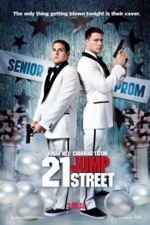
Starring: Jonah Hill
March 2012
Based on the 80s TV series of the same name starring a pre-Captain Jack Sparrow Johnny Depp, the new film version of 21 Jump Street revisits the “undercover cops go back to school to catch a bad guy” premise for the umpteenth time in film history. In the age of remakes, it was just a matter of time before this marginally successful TV property was exploited to its most ridiculous extents on the big screen. Just as nature abhors a vacuum, Hollywood hates leaving any potential revenue stream untapped.
The movie features Jonah Hill and Channing Tatum as two rookie detectives who’ve drawn the short straw and must go back to school; but hey, it actually beats their former assignment—security guards at a public park. The fish-out-of-water role reversal, where Tatum is now a bigot and bully and Hill is the life of the party, is amusing for about five minutes, but this plot device is severely belabored. Other than brief cameos by Depp and his partner, Dustin Nguyen (which is amusing for fans of the original show and confusing for those not familiar with the show), all we’re left with here is a new type of drug that’s running rampant through an inner-city high school and non-stop crass language and sexual (particularly homo-) references to fill out the story.
From the first bawdy joke over two dogs humping in the park to the climactic scene where a handcuffed man tries to retrieve his blown off phallus with his mouth, the movie is an unrelenting deluge of obscenities and indecencies of every variety imaginable…and plenty that were unimaginable before viewing this tawdry affair. The movie frequently crosses the line of bad taste and, as a default, settles for cheap laughs deriving from dunghill humor. But most of the laughing I heard in the theater was of the nervous variety as if those in the audience were looking at each other for approval…a silent “is it okay to laugh at this?” passing between them.
The real loss here is that this could’ve been a decent film had Hill and the other writers chosen a different tack. Hill and Tatum are skilled enough at both comedy and drama that some appropriate blend of the two genres could’ve made for an engaging story with occasional moments of humor punctuating episodes of hard-hitting drama. Just as the actor’s talents were wasted, so was my time and money. And I only paid two bucks…I feel sorry for the saps who paid full price for this morally reprehensible, wholly irredeemable affair.
I could go into more detail concerning the plot, what little of it there is, but I’d just be wasting your time with a potpourri of profanities and inanities. There have only been a handful of movies where, due to the subject matter or inappropriate dialog, I’ve felt like taking a shower after leaving the theater and this was definitely one of them. Clean up your act, Hollywood. Nobody’s laughing.
Rating: 1 1/2
Salmon Fishing in the Yemen (PG-13)
29/01/14 19:52
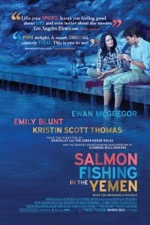
Starring: Ewan McGregor
March 2012
It’s fitting that one of the most unique movie titles in modern cinema also belongs to one of the more refreshingly original films released in recent years. That movie, based on the novel by Paul Torday, is Salmon Fishing in the Yemen. Yes, you read right…fresh water fishing in the middle of a desert. The premise seems utterly outlandish (a fact not lost on Ewan McGregor’s Dr. Alfred Jones, who initially refers to the proposed project as a “bloody joke”), but the story never takes itself too seriously and delivers a charming denouement that’s sure to please the “fairy tale ending” set.
Director Lasse Hallstrom (The Cider House Rules) uses his locations to great effect and appropriately blends traditional shots with stylistic ones (like the extreme high angle vantage of the serpentine reception desk in the office where Emily Blunt’s character works) in order to create the overall impression of a commercial film with mild indie influences. Though the film will be mostly relegated to art house theaters, Salmon Fishing certainly has commercial appeal since its style never upstages the story with excessive or ostentatious artfulness and due to the draw of its big-name stars.
The performances, as would be expected from this cast, are tremendous. Though Kristin Scott Thomas is relegated to a rather small part, she gets some of the best lines/laughs in the movie. McGregor’s seldom been as likable as he is here and the blooming Blunt is disarmingly charming. The fact that McGregor can overcome any moral objections to his character’s extramarital romance with Blunt, to the extent that spectators actually yearn for the couple to get together, is a testament to the acting acumen he now possesses (a padawan he is no longer).
One of the running themes in the film is the case of faith vs. science or random chance. Though it shouldn’t be ironic, the fact that the Arab man preaches faith to the pragmatic Caucasian man is a bit of a twist. If anything, this ancillary storyline exposes the increasingly agnostic worldview being adopted in the West. It also forwards the notion that devotion to a religion need not include the kind of fanaticism that leads adherents to crash jets into skyscrapers. The sheik in the film (Amr Waked) is a genuinely nice guy, and his portrayal goes a long way toward shattering the unhealthy stereotypes that have endured for ages, but were exacerbated by 9/11.
The “love story” here is sweet but is fairly contrived, like the through lines in all romance movies. The chemistry between principle actors is undeniable and there are several sublime moments in the film, like when McGregor names a handcrafted fly (for fishing) after Blunt’s character. However, the “wife and lover meet” passage near the end of the movie degenerates the plot into a glorified soap opera. Fortunately, minimal screen time is dedicated to this love triangle subplot and stasis is soon regained, but not until tragedy befalls the project and hope rises from the ashes…all true love must first be tested in the fiery cauldron of trial and opposition, I suppose.
Salmon Fishing probably won’t set the world (or box office) ablaze, but it’s a nice change of pace film with vivid scenery, sure-footed performances and a one-of-a-kind premise. Unlike the scores of uninspired, unbelievable dramedies being released these days, this is one film you can buy into…hook, line and sinker.
Rating: 3
This Means War (PG-13)
29/01/14 19:46
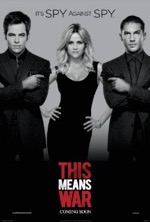
Starring: Reese Witherspoon
February 2012
The love triangle is one of the oldest narrative devices employed in romance movies. Here we have a Mr. and Mrs. Smith (2005) style spy movie where two of the top male operatives at a secret intelligence agency are in love with the same woman. The film’s relational equilateral is composed of some of today’s top talent: Chris Pine, Tom Hardy and Reece Witherspoon.
Once Pine and Hardy discover they’re in love with the same woman, the two men become instant enemies and resort to all manner of covert, underhanded or just plain infantile tactics in order to secure Reece’s affections. For the first ten minutes Pine and Hardy’s often extreme measures to sabotage each other’s chances with Reece are mildly amusing, but at the hour mark, peeling off your fingernails might seem a less painful alternative to enduring even one more minute of the pronounced and protracted silliness that runs rampant throughout the latter stages of the film. In the end, two-timing Reece must choose between her two smooth suitors. Unfortunately, her decision is predictable and stereotypical…somewhere Gloria Steinem is having a conniption.
Beyond all of the well-meaning shenanigans, some of the messages posited by the movie are utterly abhorrent—like everything that spews out of Chelsea Handler’s mouth. Besides setting the feminist movement back a couple decades (Reece is getting older, so she just has to have a man in order to find fulfillment), Reece’s character is so indecisive and so co-dependent that she goes through with Handler’s advice to sleep with both men as a tiebreaker. How in the world can Reece consider this to be good advice? I guess the main criteria for a person’s suitability as a spouse is how well they perform in the sack. Worse yet, one of the men grows a conscience and fails to consummate Reece’s experiment, thereby establishing himself as the more honorable of the two men. So naturally, Reece selects the lothario who seduced her to be her soul mate. We’re way past mild indiscretion at this point…we’re at the serious therapy stage. And the script just passes this off as normal behavior.
Reprehensible actions aside, the supposed twist ending is so contrived it might actually, and ironically, be the funniest part of the film. Though one of the characters is redeemed by way of this gimmicky ending, the denouement is far from satisfactory.
The label “run-of-the-mill rom-com” doesn’t even begin to describe the film, but for all of its inherent idiocy (and inappropriateness), the film is the kind of breezy, bawdy confection that appeals to today’s mass audience. That seems like a perfect impetus to launch into a diatribe about societal ills or ethics in media, but I think I’ll abstain. I wouldn’t want to start a war.
Rating: 2 1/2
The Secret World of Arrietty (G)
29/01/14 19:38
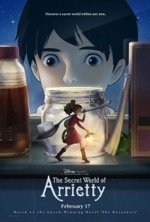
Starring: Bridgit Mendler
February 2012
The latest animated delight from Studio Ghibli is based on The Borrowers, the children’s book series written by English author Mary Norton. While long-standing fans of visionary director Hayao Miyazaki may experience initial dismay over the fact that the director didn’t…well, direct this film, they’ll be relieved to know that he serves as a co-screenwriter and one of the executive producers of the film. In his stead, director Hiromasa Yonebayashi does an admirable job of filling in for the master with a film that’s nearly as technically and artistically proficient as any of Miyazaki’s earlier films. However, Arrietty doesn’t possess the unfettered creativity of Spirited Away (2001) nor the wonder and whimsy of Ponyo (2008).
Although it would be tempting to blame Arrietty’s noticeable decline in storytelling magic on Miyazaki’s absence from the director’s chair, such an argument just wouldn’t be fair. So what prevents Arrietty from being a great Ghibli film? It certainly isn’t the Ghibli artists because the movie’s lushly mounted animation stands up to any other outing by the studio. It isn’t the stellar voice cast, headlined by Will Arnett, Amy Poehler and the timeless Carol Burnett. One could make an argument that the movie’s biggest debit is the adapted screenplay, that creativity is constrained by the pre-existing characters and narrative, even though slavish adherence to the source material doesn’t seem to be a problem here.
Although a story preoccupied with terminal illness and familial dislocation isn’t standard animated film fare, can we really blame the film’s creative letdown on these downer story elements? In the end, it may be impossible to determine why Arrietty isn’t an instant classic like the other Ghibli films. But who knows, as time passes, this film might go down as the greatest Ghibili film ever, making my argument here as moot as dial-up internet or pocket pagers.
Rating: 3
Journey 2: The Mysterious Island (PG)
29/01/14 19:22
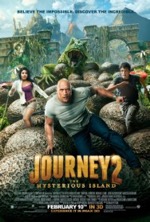
Starring: Josh Hutcherson
February 2012
The follow-up to Brendan Fraser’s Journey to the Center of the Earth (2008), Journey 2: The Mysterious Island extends the franchise which delves into the mythology, creatures and worlds of wonder created by early sci-fi writer Jules Verne. This time around, however, Fraser is out and Dwayne “The Rock” Johnson is in. Josh Hutcherson returns as young adventurer Sean Anderson. Sean’s friction with step-dad Johnson comprises most of the film’s character moments along with the handful of scenes Sean shares with his long-lost grandfather (Michael Caine), his new crush (Vanessa Hudgens) and her father, the skittish pilot (Luis Guzman). Rounding out the cast is Kristin Davis in an itty-bitty bit part as Sean’s mother.
From the title you would assume that the film would be based on Verne’s book of the same name, but you would only be 1/3 accurate. The movie’s narrative is ostensibly based on three literary classics: Verne’s Mysterious Island, Jonathan Swift’s Gulliver’s Travels and Robert Louis Stevenson’s Treasure Island. The common denominator of each tale (besides rip-roaring, old-tyme adventure) is the prominent showcasing of an island as the central locale. Averring that the island in each of these classics is one and the same is a clever and bold conceit, one that keeps the plot wheels steadily churning along through muddy musings and soft-core familial strife in the movie’s early goings.
However, the mash-up premise is quickly jettisoned just about the time Guzman steers his wing-and-a-prayer chopper into, not away from, a violently swirling waterspout. In all fairness, we do get to see a miniature pachyderm a la the Lilliputians as well as Captain Nemo’s Nautilus, but where does the movie borrow from Treasure Island…a gold-spewing volcano? More to the point, what if screenwriters Brian and Mark Gunn (no relation to Ben I’m sure) had capitalized on the original premise by weaving a tapestry rife with allusions and events from the three books instead of merely teasing the concept?
As a quote unquote family film, the movie tries to make object lessons out of wrong choices made by the characters, particularly Guzman’s greedy, gold-luster—he’s drawn to the mountain of gold like a giant bird to a giant bee (oops, one paragraph too early to use that analogy). The story also makes occasional, most often feeble, attempts at foregrounding modern parenting. Guzman wants to send his daughter to college so he goes in search of a bolder-sized gold nugget…with the way inflation is escalating, he might need two. Johnson desperately tires to connect with Hutcherson, but the best advice he can offer the teen is to woo young hotties with Johnson’s patented “pec pop.” Consider this scene the film’s nadir.
The zenith of the film, despite its utter absurdity, is the rapturous flight of the bumblebee’s sequence. The story really takes flight when the adventurers ride giant bees like airborne steeds, and the action kicks into high gear when the bees are stalked by even bigger birds of prey. Honorable mention goes to the sequences involving the sleek (but too small?) Nautilus, although restarting the engines with the charge from an electric eel is a bit farfetched even by this movie’s whimsical standards.
Where the acting is concerned, a more eclectic cast you’re not likely to find and they all turn in serviceable, if not award-winning, performances. Even though all of Johnson’s roles aren’t exactly the same he plays them all as such. On some future film the director will figure out that it’s more cost effective to replace Johnson with a cardboard standup of the actor with looped lines…the result would be no different than his performance here or in any of his other films.
Although the inestimable Caine never misfires, his character, as written, isn’t as enjoyable as would be expected. In fact, it’s hard to remember a Caine character that’s this unlikeable…he needlessly bickers with Johnson’s character and the constant cavalcade of condescension is off-putting. I certainly don’t fault the actor; I fault the Gunn’s for failing to give his character any redeeming characteristics.
In the end, though no better or worse than its predecessor, Journey 2 squandered a golden opportunity to creatively integrate exciting elements from the three literary classics it references into its yarn. Instead, the story defaults to simply serving up a reheated version of last summer’s action flick. Maybe for the next film, the writers can emphasize a solid plot with fleshed-out characters over SFX and action sequences…in other words, the polar opposite of this Journey.
Rating: 2 1/2
Chronicle (PG-13)
29/01/14 19:08
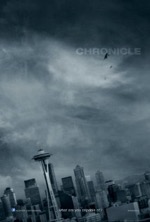
Starring: Dane DeHaan
February 2012
So here we have The Blair Witch Project (1999) meets Cloverfield (2008) meets TVs Heroes (2006-2010) meets every teen angst movie ever made. Shot almost entirely from the POV of the main character on his camcorder, Chronicle centers on a group of high school guys who discover an alien ship buried beneath a field. The result of their exposure to the alien technology is that they begin exhibiting superpowers which, of course, is a recipe for disaster since we’re dealing with horny, hot-headed teenage males.
One of the lads in particular, upon coming to the realization that he’s now an apex predator, starts committing random acts of mayhem…because he can. In the end, the only person who can stop him is his best friend. A city-smashing melee ensues, which recalls the climactic battle between the titular hero and his three nemeses in Superman II (1980), and the results are predictably tragic.
No one can say that this film isn’t a valiant attempt at creating a new sensation, but it rides on the coattails of many similarly themed efforts like the ones listed above. Additionally, there are undeniable shades of Shakespeare here and even allusions to Star Trek—the original series’ pilot saw Captain Kirk killing his megalomaniacal best friend, Gary Mitchell, in order to save his crew and the universe as we know it.
In the final analysis, Chronicle is a unique hand-held project that tells a decent story and is mildly diverting, if not earth-shattering. Maybe Chronicle II will provide some variety by cutting shots taken by two camera-wielding students.
Rating: 2 1/2